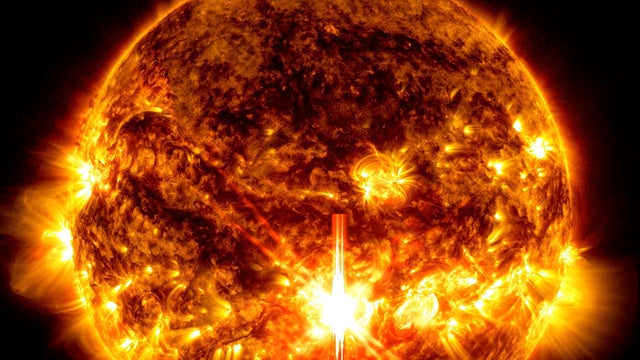

No response returned

The emergence of renewable energy like wind and solar as a viable alternative to oil, gas and other fossil fuels has raised critical questions about which form of power offers the best value today — a debate made all the more urgent by the ravages of .
In the U.S., where energy policy has been shaped by politics for more than a century, the battle continues to play out at the highest levels of government. Former President Biden delivered one of the biggest endorsements of renewable energy in the form of the 2022 Inflation Reduction Act (IRA), which offered tax credits and rebates to businesses, organizations and households that invest in solar, wind and geothermal technologies.
By contrast, President Trump has been a staunch supporter of the oil and gas industry. During his inauguration in January, he reaffirmed his commitment to fossil fuel production, saying, "We will be a rich nation again, and it is that liquid gold under our feet. That will help to do it."
Within six months of taking office, Mr. Trump signed the "One Big Beautiful Bill Act" into law, which while simultaneously expanding tax breaks for the oil and gas industries. Separately, his administration has offshore wind leasing and for clean energy projects to qualify for federal dollars.
On the global trade front, Mr. Trump has issued a flurry of tariffs on , which experts say will translate into higher costs for energy projects that rely on imports. The White House is pushing these policies amid concerns over , with average electricity costs up 5.5% from a year ago, to the Bureau of Labor Statistics.
To get to the bottom of which form of energy is the cheapest, Autos News analyzed the cost to produce coal, gas, nuclear, wind and solar energy, including the impact of tax incentives, tariffs and other factors.
Multiple criteria come into play in trying to assess the cheapest form of energy. These include consumers' monthly costs; the cost to produce energy; and the potential social cost energy production can have on a community's health and the environment. External factors like tax incentives and fluctuations in the economy also can affect the price it costs to heat and cool our homes.
Autos News set out to answer the question using what's called the Levelized Cost of Energy, or LCOE, a commonly cited benchmark for wholesale energy costs. LCOE is the price that a power-generating facility must receive for its electricity to cover all its expenses — including capital, equipment, maintenance and other financing costs — over the lifespan of a project.
A 2025 LCOE from investment bank Lazard shows the cost to produce energy without any government subsidies and how that changes when you layer in other factors, such as tax subsidies provided under the Inflation Reduction Act.
By comparison, only in recent decades have renewable energy projects drawn a larger share of federal dollars. The push for renewables accelerated in the 1970s, when the U.S. was facing an energy crisis defined by , to Congress.gov.
Lazard's report shows how the LCOE for renewable energy fluctuates when you account for certain provisions of the IRA aimed at lowering the cost of developing clean energy projects. Those include the investment tax credit (ITC), production tax credit (PTC) and energy community bonus, which increases the value of the ITC and PTC by 10% for projects in certain areas.
Lazard's calculations assume these credits will be in place for 10 years. Notably, however, the Republican-backed "big, beautiful bill" signed into law by Mr. Trump this summer is slated to phase out those credits over the next two years.
Although Lazard examines how the IRA affects renewable energy prices, it doesn't factor in any government subsidies flowing to the oil and gas industry, which vary widely and can be difficult to assess.
The Environmental and Energy Study Institute, a bipartisan nonprofit research group, estimates that direct U.S. subsidies to the fossil fuel industry amount to at least $20 billion per year. However, the FracTracker Alliance, a nonprofit focused on the impact of fossil fuels, the industry receives an estimated $760 billion annually in government subsidies and tax breaks.
More benefits will go to the oil and gas industries under the "big, beautiful bill." A June from the Joint Committee on Taxation estimates that the legislation will funnel nearly $18 billion in tax incentives to the oil and gas industry over the next 10 years.
Oil and gas companies have lauded the new law as a win for the industry. Sunil Mathew, chief financial officer of Occidental Petroleum, said during a recent company earnings call that the measure "will provide significant cash tax benefits to Oxy." He expects the law will save Occidental $700 million to $800 million in "cash taxes" by the end of next year.
Mr. Trump's tariffs are also projected to alter the cost it takes to fund energy projects in the U.S. To gauge the impact of tariffs on energy costs, Autos News turned to a model created by global data and analytics company Wood Mackenzie.
In the following chart, dark green indicates a scenario in which the U.S. hasn't applied any country-level tariffs, but still maintains levies on copper, steel and aluminum imports; the medium shade of green represents current baseline tariffs imposed by the U.S. since Mr. Trump resumed office in January through August 7; and the light green indicates if trade relations with a U.S. economic partner is likely to worsen or deteriorate.
As depicted, U.S. tariffs are projected to hit battery storage production the hardest. Chris Seiple, vice chairman of the power and renewables group at Wood Mackenzie, noted that while some energy equipment is produced domestically, other tech, such as battery cells, mostly comes from abroad, making them more susceptible to tariffs.
"The vast majority of our battery cells come from China," he said. "And so the cost of a battery project is going to go up by a certain percentage."
"There is no one cheapest form that you can run the whole system on, and in fact, it depends on combining them in ways to [get] the cheapest possible cost," Borenstein said.





